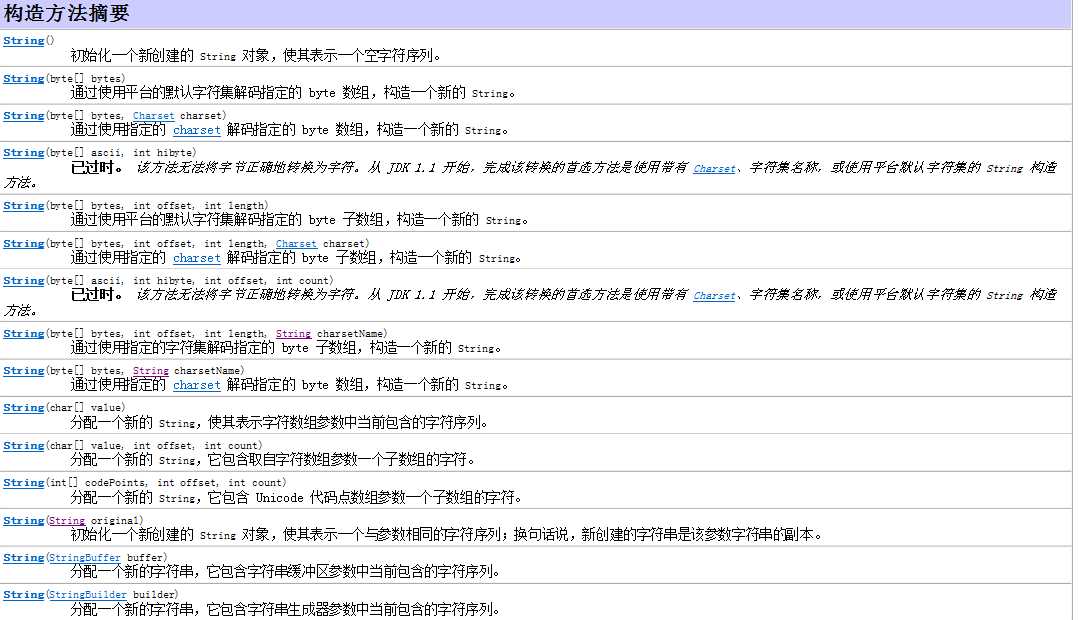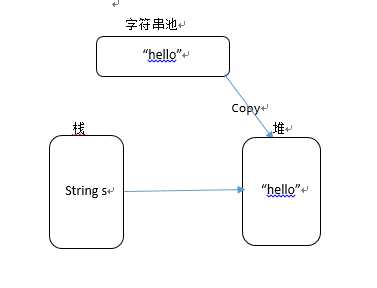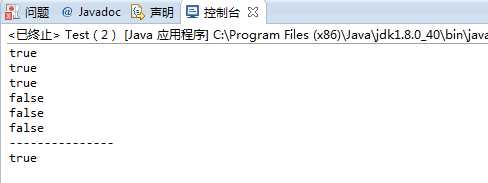标签:
一、概述
Java是以String类型的对象来实现字符串。String是一个类,当创建一个String对象后,所创建的字符串是不能改变的。在需要使用可修改的字符串时,Java提供两个选择—StringBuffer和StringBuilder。注:声明为String引用的变量在任何时候都可以改变,以指向一些其他的String对象。
二、String构造函数

String s1="hello"与String s2=new String("hello")的区别:
String类在内存中管理一个字符串常量池(常量池的一部分),池中所有相同的字符串常量被合并,只占用一个空间。
String s1=”hello”,先看池中有没有hello,没有就创建一个hello字符串对象。即采用此方法创建0或者1个对象。
String s2=new String(“hello”),这里先在池中创建一个hello对象,同s1,然后new String()时,将hello对象复制到堆heap中,s2指向堆中的hello。采用此种方法时创建1或2个对象(当池中有hello时,创建一个对象)。
内存图如下:

三、String类的方法函数
String类有很多方法,这里只介绍几种常见的函数:
1、字符串的长度:
int length();
2、字符串转换
每个类都会实现toString方法,因为它是由Obect定义的,对于大多数的自创建的类来说,通常要重写toString()并提供自己的字符串表达式。
eg:
1 class Box 2 { 3 int x; 4 int y; 5 Box(int x,int y) 6 { 7 this.x=x; 8 this.y=y; 9 } 10 public String toString() 11 { 12 return "test_x"+"-----"+x+"\n"+"test_y"+"-----"+y; 13 } 14 } 15 public class Tset 16 { 17 public static void main(String[] args) 18 { 19 Box b=new Box(1,3); 20 System.out.println(b); 21 } 22 23 }
显示结果为:

疑问:看了一下println的源码,不知道此处输出结果为何是如此?
1 private void write(String s) { 2 try { 3 synchronized (this) { 4 ensureOpen(); 5 textOut.write(s); 6 textOut.flushBuffer(); 7 charOut.flushBuffer(); 8 if (autoFlush && (s.indexOf(‘\n‘) >= 0)) 9 out.flush(); 10 } 11 } 12 catch (InterruptedIOException x) { 13 Thread.currentThread().interrupt(); 14 } 15 catch (IOException x) { 16 trouble = true; 17 } 18 }
3、字符抽取
charAt(): 返回指定索引处的 char 值。 getChars():一次抽取多个字符。 getBytes():将字符存储在字节数组里。
4、字符串比较
equals()和==:equals()方法是比较String对象中的字符,“==”运算符是比较两个对象是否引用同一实例。
eg:
1 public class Test 2 { 3 public static void main(String[] args) 4 { 5 String s1=new String("hello");//创建2个对象,一个pool和一个堆里面 6 String s2="hello";//创建1个对象,s2指向pool里面的"hello"对象 7 String s3="hello";//创建0个对象,指向s2指向pool里面的那个对象 8 String s4=s2;//创建0个对象,指向s2,s3指向pool里面的那个对象 9 String s5=new String("hello");//创建1个对象在堆里面,注意,与s1没关系 10 11 System.out.println(s2=="hello");//true 12 System.out.println(s2==s3);//true,因为指向的都是pool里面的那个"hello" 13 System.out.println(s2==s4);//true,同上,那么s3和s4...:) 14 System.out.println(s1==s5);//false,很明显,false 15 System.out.println(s1==s2);//false,指向的对象不一样 16 System.out.println(s1=="hello");//false 17 System.out.println("---------------"); 18 s1=s2; 19 System.out.println(s1=="hello");//true 20 } 21 }
执行结果:

boolean startsWith(String prefix):判断给定的String是否以特定的字符串开始。 boolean startsWith(String prefix,int toffset):判断此字符从指定索引开始的字符串是否以指定的前缀开始。 endsWith():判断给定的String是否是以特定的字符串结束。 compareTo():用于比较字符串大小,并考虑大小写字母。 compareIgnoreCase():比较字符串大小并忽略大小写字母。
5、查找字符串
isdexOf():查找字符或子串第一次出现的位置
lastIndexOf():查找字符或者子串最后出现的位置
6、更改字符串
因为String对象是不能改变的,当需要更改一个字符串时,就必须将他复制到一个StringBuffered中,后者使用下列方法,在更改后会构造一个新的字符串副本。
substring(int startIndex):返回从startIndex开始到调用字符串结束的子串的一个副本 substring(int startIndex,int endIndex),指定起点和终点,返回这中间的字符串,不包括终点。 concat():连接两个字符串,与“+”运算符相同。 replace(char originial,char replacement):用一个字符在调用字符串中所有出现另一个字符的地方进行替换。 replace(CharSequence originial,CharSequence replacement):用一个字符串序列替换另一个字符串序列。 trim():返回调用字符串对象的一个副本,但是所有起始和结尾的空白符都被删除了(字符中间的空白符未被删除)。
7、改变字符串中字符的大小写
toLowerCase():将所有字符改为小写
toUpperCase():将所有字符改为大写
四:StringBuffer类
StringBuffer是String的一个对等类,提供了字符串的许多功能,可增长、可改写。
这里只介绍几个StringBuffer类的方法函数:
1、append():将任何数据类型的字符串表示连接到调用的StringBuffer对象的末尾。
当定String对象使用“+”运算符时,经常要调用append方法。
StringBuffer s=new StringBuffer("hello"); System.out.print(s.append(" world"));
2、inser(int index,String str):将一个字符串插入到另一个字符串中。
3、reverse():颠倒StringBuffer对象中的字符
4、delete(int startIndex,int endIndex),delete(int loc):调用对象中删除一串字符。
五、StringBuilder类
除了一个重要的区别之外,与StringBuffer等同,这个区别是他不是同步的,意味着他不是线程安全的,其优势是更快的性能,在使用多线程时必须使用StringBuffer。
标签:
原文地址:http://www.cnblogs.com/xujian2014/p/4437748.html